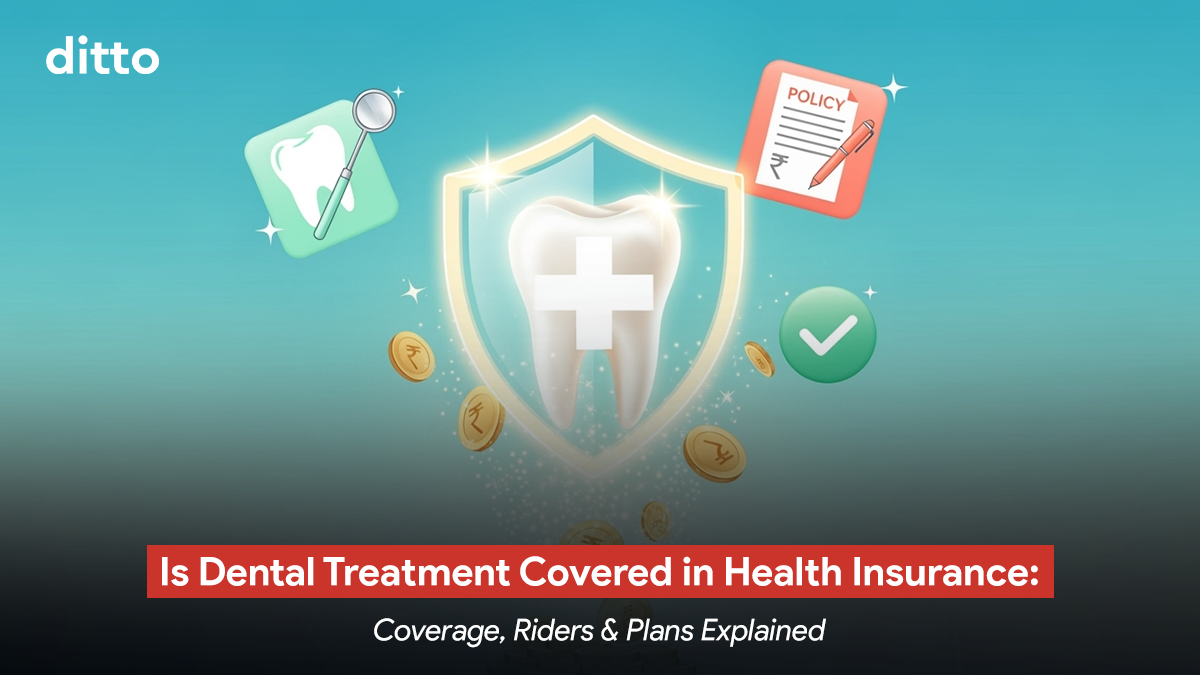| Is dental treatment covered in health insurance? Standard health plans cover dental expenses if caused due to an accident or disease, including examinations, fillings, crowns, extractions, and surgery. However, routine dental treatment is generally not covered as a standard feature in health insurance plans in India. Coverage mostly comes through outpatient (OPD) riders, which include treatments like check-ups, fillings, root canals, and extractions, but often exclude routine cleanings and cosmetic procedures, and have coverage limits. |
Is dental treatment covered in health insurance? It’s a question many Indians ask but few have a straightforward answer to. With dental care costs soaring unpredictably, 74% of Indians pay over ₹1,500 for a single tooth filling.
Additionally, one in three spend more than ₹10,000 for a root canal, according to a recent India Today survey. Clearly, dental health can quickly become a significant financial burden. Yet, most health insurance policies do not typically cover dental treatments which leaves many to bear expenses out of pocket.
In this guide, we delve into dental treatment in health insurance, explaining what’s typically covered, what isn’t, and how riders, add-ons, or specialized plans can help. We also share our take on whether you should buy an OPD rider and provide practical tips on how to choose the right option based on your dental needs and budget.
You can book a FREE consultation here. Slots are running out, so make sure you book a call now.
What Is Dental Treatment in Health Insurance?
Dental treatment in health insurance refers to care involving the teeth or their supporting structures such as examinations, fillings, crowns, extractions, and even surgery. According to IRDAI, such treatments are covered only when they’re medically necessary due to a disease or injury and are performed by a qualified practitioner. In simple terms, your plan may cover dental expenses if they result from an accident like a car crash, a fall, or any other unexpected injury.
Why Routine Dental Care Is Usually Not Covered?
Routine dental care is mostly considered elective or preventive rather than medically necessary. Since dental treatments like teeth cleaning or orthodontics are planned maintenance and not unexpected medical emergencies, insurers often exclude them. Covering routine dental care would increase administrative costs and premiums significantly which makes health plans less affordable for many.
Popular Health Insurance Plans Covering Dental Treatment
| Before we discuss the list, here’s how we decide what plans to feature. At Ditto, every health plan goes through our six-point evaluation framework. It doesn’t mean these are the only good plans, but that they stand out after being scored across all six pillars. You can learn more about how we evaluate health insurance plans here |
Some health insurance plans do provide coverage for dental treatment but with specific limits and conditions. Here's how some popular plans in India cover dental care:
| Insurance Plan | Dental Treatment Coverage | Highlights |
|---|---|---|
| Star Health Super Star | Dental check-up & cleaning: consultation, dental X-ray (IOPA), and scaling. | Available only on cashless basis; Covered for one insured per policy year (in individual policy, each insured can avail once/year) |
| ; Facility available only in 2nd & 3rd policy year for new policyholders. | ||
| Tata AIG MediCare Premier | OPD dental treatment after 2 years of continuous coverage. Covers root canal treatment (single/multiple sittings), tooth extraction(s), and fillings. | Annual dental cover ₹10,000–₹25,000 (based on sum insured); Separate limit (doesn’t affect cumulative bonus). Dental exclusion not applicable for this benefit. |
| Care Plus (Youth & Complete variants) | Coverage for acute dental treatments on natural teeth, if prescribed in writing by a licensed dentist. | • Coverage capped by sum insured: |
| – ₹5–7 Lakhs → up to ₹1,500 | ||
| – ₹10–25 Lakhs → up to ₹2,500 | ||
| • No loading charges on pre-existing conditions | ||
| Niva Bupa Health Premia Platinum | OPD dental coverage up to ₹50,000 under OPD Treatment & Diagnostic Services. Covers treatments, procedures, preventive and restorative services for disease/disorder of natural teeth. | • Coverage applies only to natural teeth |
| • Excludes implants, CAD/CAM restorations & bone grafts | ||
| • Designed for high sum insured policies (₹1–3 Cr) | ||
| Bajaj Allianz Health Care Supreme Plan | Covers OPD dental consultations and procedures under the outpatient expenses benefit. | Includes essential treatments such as root canal procedures and extractions up to ₹25,000. |
| Aditya Birla Activ Health Platinum Enhanced | One consultation, one X-ray, and one cleaning per year, covered up to policy sub-limits on a cashless basis at empanelled providers in select cities. | Dental consultation and diagnostic investigations are in-built, cashless at empanelled providers; broader treatments require an OPD rider or separate dental insurance and are covered only for accident-related hospitalization. |
How Is Dental Treatment Covered in Health Insurance?
Dental treatment in health insurance is available through these methods:
- Inpatient Hospitalization:
Dental surgeries or treatments requiring hospitalisation and anaesthesia, often following accidents or severe dental diseases, are covered under the inpatient benefits of health insurance. - Outpatient (OPD) Dental Treatment:
Many plans offer outpatient dental cover via add-ons, that covers dental consultations, diagnostics, root canal treatments, fillings, crowns, and extractions without hospitalization. These benefits usually have annual monetary limits. - Annual Checkups:
Some comprehensive plans include dental examination as part of annual health checkups, especially for children under 18 for enabling preventive oral care. For example: Care Supreme with annual health checkup add-on. (policy wording page 14)
Claim Process for Dental Treatment in Health Insurance
When dental treatment is covered, usually due to accidents requiring hospitalization or dental surgeries, you can claim expenses through:
- Cashless Claims:
If treatment is at a network hospital, inform the insurer immediately (within 24 hours for emergencies). Submit a pre-authorization form via the hospital. Upon approval, the insurer pays the hospital directly. - Reimbursement Claims (More common):
For non-network hospitals or standalone dental clinics, pay upfront and submit claim documents to the insurer within deadlines (usually 15-30 days after treatment). The insurer verifies and reimburses eligible amounts.
Key Claim Criteria:
- The dental injury must be directly caused by a covered accident or illness.
- For most health insurance plans, hospitalisation (typically 24 hours or more) or a day care surgical procedure is required for inpatient claim eligibility.
- Complete and accurate documentation (medical reports, bills, accident reports) proving causation and treatment details is mandatory for claim approval.
Important Things to Remember When Considering Dental Treatment in Health Insurance
- In-Patient vs. Out-Patient: The main factor is where the treatment happens and why. Standard plans usually cover dental treatment only if it’s an accidental injury requiring hospitalization for 24 hours or more, or if it qualifies as a covered day-care procedure (for example, a fractured jaw or loss of teeth in a car accident).
Routine dental care, like check-ups, fillings, and cleanings, is considered OPD (out-patient) and is not covered unless you buy an OPD add-on or rider.
- Monetary Limits (Sub-Limits): If you opt for an OPD rider, be aware of the financial caps. Coverage is almost always subject to a low annual limit, often between ₹5,000 and ₹15,000. High-cost procedures like root canal treatments or implants can easily exceed this limit, which means you have to pay the remaining cost out of pocket.
- Waiting Periods: Most OPD riders come with a waiting period ranging from 30 days to 2 years before you can claim routine dental benefits like fillings or cleanings. The waiting period is usually waived only for accidents.
- Specific Exclusions: Policies are strict about what they do not cover. Cosmetic procedures such as teeth whitening, veneers, or cosmetic bonding are generally excluded.
Elective appliances like dentures, partial or complete plates, and most types of braces (orthodontics) are also excluded. Dental implants are typically excluded unless they are the result of a severe, covered accident requiring hospitalization. Pre-existing dental conditions are usually not covered either, subject to policy terms.
Even if some cosmetic or preventive treatments are allowed under specialized plans or OPD riders, they often have strict limits or price caps.
- Premium vs. Benefit Trade-Off: OPD riders add to your premium, but the annual benefit is limited. For example, paying ₹3,000 extra for a ₹10,000 dental limit effectively pre-pays 30% of the maximum claim. For basic treatments like cleanings or minor fillings, paying out-of-pocket can sometimes be more cost-effective than buying a rider with low limits and waiting periods.
Golden Rule: Always read the “Inclusions and Exclusions” and “Sub-limit” clauses related to dental treatment in the policy document before purchasing a plan or rider. Understanding these details ensures you know exactly what is covered, what isn’t, and how much you can claim.
Dental Treatment in Health Insurance: Rider, Standalone, and Group Plans
Deciding how to cover dental treatment in health insurance in India requires understanding your needs and the options available.
The Reality in India: Comprehensive standalone dental insurance plans are still uncommon, and most individual health insurance policies cover dental treatment only through OPD riders. For organizations, group dental plans are increasingly being offered to cover routine and major dental procedures not included in standard health policies.
1. Dental Rider – Inbuilt or Paid Add-on
Some health insurance plans in India include limited dental coverage inbuilt (e.g., one consultation, cleaning, or X-ray per year). In other cases, dental benefits are available only as a paid OPD add-on rider to the main health policy.
- Pros: Convenient and easy to manage alongside your main health insurance. Encourages preventive care and the premium often qualifies for tax benefits under Section 80D.
- Cons: As discussed earlier, dental riders usually come with low limits, waiting periods, and restricted inclusions, which reduces their value for major procedures. Claims are often on a reimbursement basis, requiring you to pay first and submit documents.
2. Standalone Dental Plans
- Pros: Focused coverage for preventive, routine, and advanced dental procedures; Predictable costs for consultations, treatments, and procedures; Cashless treatment and easy claims at network clinics; Access to standardized care across partner clinics; Can include teledental consults, annual check-ups, and treatment discounts.
- Cons: Rare in India, premiums tend to be high, coverage is restricted to dental care only, so medical expenses are not included; benefits are only available at partnered clinics.
- Examples: Clove Dental Membership Plans – Their Premium Dental Health Plan (₹590) includes free consultations, free X-rays, and a treatment coupon worth ₹1,800 redeemable for dental procedures, valid for six months across 600+ clinics.
Toothlens Dental Plans – Starting at ₹125/month, offering cashless coverage for check-ups, cleanings, fillings, root canals, crowns, extractions, dentures, and more across 300+ partner clinics. Plans include instant claims, no waiting period, teledental consultations, annual complimentary checks, and discounts on pre-existing conditions.
3. Group Insurance Policies
Group dental insurance policies are typically offered by employers or organizations as part of employee health benefits. Unlike individual health insurance, which usually covers dental care only in cases of accidents requiring hospitalization, group policies can be structured to include routine and advanced dental treatments.
- These may cover services like fillings, gum treatments, root canals, crowns, extractions, dentures, and even dental surgeries requiring hospitalization.
- Coverage is usually provided through a network of empanelled dental clinics, with cashless treatment, pre-authorization for certain procedures, and value-added services like regular checkups or teleconsultations.
- Waiting periods and limits vary by plan, but the aim is to provide employees with financial assistance for routine care and emergencies that standard health policies exclude.
Example: HDFC ERGO’s CHOMP plan is one such group dental insurance product. It offers cashless treatment at 2,500+ clinics, covers both outpatient and inpatient procedures, includes dental checkups and video consultations, and is sold only through employers.
Should You Buy Dental Treatment in Health Insurance: Ditto’s Take
- For Minimal Needs (Routine Check-ups/Cleanings):
The cost of a rider along with a long waiting period might not be worth the minimal coverage. You may be better off setting aside that premium amount to pay for your annual check-up and cleaning out-of-pocket, which gives you complete freedom in choosing your dentist. - Moderate Needs (Fillings, Simple RCTs/Extractions):
A dental rider can serve as a financial safety net for common procedures. Compare your premium with the coverage offered and ensure the procedures you expect are included after the waiting period. - Extensive Needs (Implants, Braces, Complex Surgeries):
Standard riders and most standalone plans won’t suffice. These procedures are usually excluded. For these expensive and planned procedures, the only way to cover them is to: look for an ultra-premium, very high OPD policy (which are expensive); seek a dedicated dental savings/discount plan (not insurance, but negotiated rates); or self-finance by creating a separate savings fund.
Why Talk to Ditto for Your Insurance?
At Ditto, we’ve assisted over 8,00,000 customers with choosing the right insurance policy. Why customers like Tharun below love us:

✅No-Spam & No Salesmen
✅Rated 4.9/5 on Google Reviews by 15,000+ happy customers
✅Backed by Zerodha
✅Dedicated Claim Support Team
✅100% Free Consultation
You can book a FREE consultation here. Slots are running out, so make sure you book a call now.
Key Takeaways
- Standard health plans usually cover dental only in case of accidents or hospitalization; routine care generally requires an OPD rider or a specialized plan.
- Dental OPD riders and add-ons come with low annual limits, which can be easily exceeded by major treatments like RCTs, implants, or braces.
- For OPD dental procedures that aren’t due to an accident, most plans impose waiting periods, so you’ll need to wait before making a claim.
- Decide based on your dental needs: minimal care may be self-paid, moderate care can be covered by a rider, and extensive or cosmetic procedures may require specialized plans or self-funding.
FAQs
Is dental treatment covered in health insurance?
Yes, dental treatment resulting from disease or accidents that require hospitalization is generally covered. Routine dental care, such as check-ups, cleanings, or cosmetic procedures, is not included.
What types of dental treatments does health insurance cover?
Dental surgeries, root canal treatments, fillings, extractions, and crowns needed due to injury or illness are typically covered.
Are routine dental checkups covered?
Routine checkups and cleanings are mostly excluded unless included as part of an annual health checkup or rider.
Can cosmetic dental treatments like braces be claimed?
No, cosmetic procedures such as braces, aligners, veneers, dentures, and whitening are generally excluded.
What is a dental insurance rider?
A dental rider is an add-on premium enhancing outpatient dental coverage beyond the base health plan’s limits.
What is the claim process for dental treatment?
Claims can be cashless at network hospitals or reimbursement-based at non-network clinics, requiring proper documentation and timely submission.
Last updated on:








